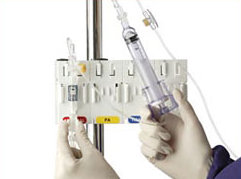Categorised under:
Anaesthesia
>
Miscellaneous
>
Miscellaneous
Iatrogenic anaemia, spillage, infection control and needlestick injuries are all sensible reasons to seek newer ways to take blood samples in patients with indwelling intravascular catheters. The Safeset system is one of several products available on the market. The system can be purchased as a standalone one, or used in conjunction with a variety of existing vascular line systems. The main element which makes this interesting is a reservoir syringe that allows the initial drawback volume to be re-injected into the patient once a blood sample has been taken.
Iatrogenic anaemia, spillage, infection control and needlestick injuries are all sensible reasons to seek newer ways to take blood samples in patients with indwelling intravascular catheters.
The Safeset system is one of several products available on the market.
 Features:
Features:The system can be purchased as a standalone one, or used in conjunction with a variety of existing vascular line systems.
The main element which makes this interesting is a reservoir syringe that allows the initial drawback volume to be re-injected into the patient once a blood sample has been taken.
Although the system is intuitive and simple to use with minimal training for staff accustomed to traditional arterial or central lines, there are several issues of note.
Firstly, the system adds weight and bulk to the line, which, depending on positioning, may cause dislodgement and catching on the bedside etc. This is a relatively minor inconvenience for patients and nursing staff.
Of more concern is the cost of the disposable elements of the Safeset system. The needle-less Luer lock sampling valve connector has a limited number of uses, and is relatively expensive.
Unfortunately, although I like the idea, and can rationalise the benefits of closed systems, I would need to have access to cost benefit figures before being able to justify purchase of this device in my institution. This is likely to be the case in many NHS facilities with separate financial “siloes” each required to minimise expenditure
Disposables cost, evidence of overall cost savings.
Dr Ian Nesbitt, Conslutant Anaesthetist, Newcastle upon Tyne, UK - No Conflict Declared
Ian Nesbitt qualified from Newcastle upon Tyne Medical School, trained in the UK, Australia and New Zealand. He works as a consultant in the NHS in Anaesthesia & Critical Care.

Did you know you can Register for FREE with this website?
Registration gives you full access to all of the features of WhichMedicalDevice. Find out more ...
WhichMedicalDevice is a FREE resource created by clinicians for clinicians.
Registration is free and gives you unlimited access to all of the content and features of this website.
Find out more...Registration is free and gives you unlimited access to all of the content and features of Which Medical Device. Find out more...
Which Medical Device is a community of clinicians sharing knowledge and experience of the devices and procedures we use on a daily basis. We ask that our members register with us so that we can maintain the unbiased and independent nature of our content. Registration is quick and free.
We do not make your details available to any third parties nor do we send unsolicited emails to our members. You can read our Privacy Policy here.